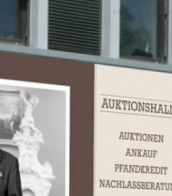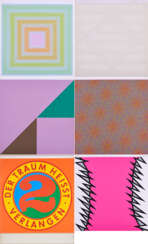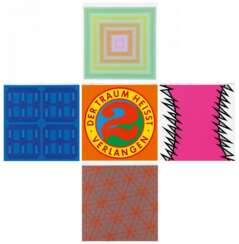domberg

Luitpold Domberger was a graphic designer and pioneer of artistic screen printing in Germany. In 1949, he founded his first print shop in Stuttgart. Domberger's skill as a stencil artist gained international renown and paved the way for many collaborations with international artists. Domberger also promoted the professionalisation of screen printing and assisted many young artists in their careers in his studio. Domberger specialised in the intricate hand-cutting of stencils and made extensive use of fluorescent inks and other new materials in his collaborations. In addition to creating works from sketches by other artists, Domberger made a number of his own stencils in a rigid style reminiscent of works associated with the minimalist and op-art movements.


Luitpold Domberger was a graphic designer and pioneer of artistic screen printing in Germany. In 1949, he founded his first print shop in Stuttgart. Domberger's skill as a stencil artist gained international renown and paved the way for many collaborations with international artists. Domberger also promoted the professionalisation of screen printing and assisted many young artists in their careers in his studio. Domberger specialised in the intricate hand-cutting of stencils and made extensive use of fluorescent inks and other new materials in his collaborations. In addition to creating works from sketches by other artists, Domberger made a number of his own stencils in a rigid style reminiscent of works associated with the minimalist and op-art movements.


Luitpold Domberger was a graphic designer and pioneer of artistic screen printing in Germany. In 1949, he founded his first print shop in Stuttgart. Domberger's skill as a stencil artist gained international renown and paved the way for many collaborations with international artists. Domberger also promoted the professionalisation of screen printing and assisted many young artists in their careers in his studio. Domberger specialised in the intricate hand-cutting of stencils and made extensive use of fluorescent inks and other new materials in his collaborations. In addition to creating works from sketches by other artists, Domberger made a number of his own stencils in a rigid style reminiscent of works associated with the minimalist and op-art movements.


Luitpold Domberger was a graphic designer and pioneer of artistic screen printing in Germany. In 1949, he founded his first print shop in Stuttgart. Domberger's skill as a stencil artist gained international renown and paved the way for many collaborations with international artists. Domberger also promoted the professionalisation of screen printing and assisted many young artists in their careers in his studio. Domberger specialised in the intricate hand-cutting of stencils and made extensive use of fluorescent inks and other new materials in his collaborations. In addition to creating works from sketches by other artists, Domberger made a number of his own stencils in a rigid style reminiscent of works associated with the minimalist and op-art movements.


Luitpold Domberger was a graphic designer and pioneer of artistic screen printing in Germany. In 1949, he founded his first print shop in Stuttgart. Domberger's skill as a stencil artist gained international renown and paved the way for many collaborations with international artists. Domberger also promoted the professionalisation of screen printing and assisted many young artists in their careers in his studio. Domberger specialised in the intricate hand-cutting of stencils and made extensive use of fluorescent inks and other new materials in his collaborations. In addition to creating works from sketches by other artists, Domberger made a number of his own stencils in a rigid style reminiscent of works associated with the minimalist and op-art movements.


Luitpold Domberger was a graphic designer and pioneer of artistic screen printing in Germany. In 1949, he founded his first print shop in Stuttgart. Domberger's skill as a stencil artist gained international renown and paved the way for many collaborations with international artists. Domberger also promoted the professionalisation of screen printing and assisted many young artists in their careers in his studio. Domberger specialised in the intricate hand-cutting of stencils and made extensive use of fluorescent inks and other new materials in his collaborations. In addition to creating works from sketches by other artists, Domberger made a number of his own stencils in a rigid style reminiscent of works associated with the minimalist and op-art movements.


Luitpold Domberger was a graphic designer and pioneer of artistic screen printing in Germany. In 1949, he founded his first print shop in Stuttgart. Domberger's skill as a stencil artist gained international renown and paved the way for many collaborations with international artists. Domberger also promoted the professionalisation of screen printing and assisted many young artists in their careers in his studio. Domberger specialised in the intricate hand-cutting of stencils and made extensive use of fluorescent inks and other new materials in his collaborations. In addition to creating works from sketches by other artists, Domberger made a number of his own stencils in a rigid style reminiscent of works associated with the minimalist and op-art movements.


Hanne Darboven was a German conceptual artist known for her large-scale installations, drawings, and writings that explore the intersections of mathematics, language, and time.
Darboven studied at the Hochschule für Bildende Künste in Hamburg. In the 1960s, she became associated with the Conceptual Art movement, creating works that often involved systems of numerical and textual notation.
In the 1970s, Darboven began to produce her signature installations, which combined writing, drawing, and found objects to create immersive environments that explored complex systems of meaning and structure. One of her most famous works is "Kulturgeschichte 1880-1983", a monumental installation consisting of 1,590 framed sheets of paper, each containing a series of numbers, letters, and symbols that chart the course of modern history.
Throughout her career, Darboven continued to explore the relationship between language, numbers, and time, often drawing inspiration from her own life and experiences. She exhibited her work widely in Europe and the United States, and was the subject of numerous retrospectives and solo exhibitions.
Her legacy as a pioneering conceptual artist continues to be recognized and celebrated by the art world today.
.


Roy Fox Lichtenstein, an American icon of the Pop Art movement, is celebrated for his comic strip-inspired art. Born in 1923 in New York City, Lichtenstein's journey into the art world was marked by various phases, evolving from Cubism and Abstract Expressionism to the distinctive Pop Art style he is renowned for.
Roy Lichtenstein's artistic career gained momentum in the 1960s, a period during which he embraced the comic strip as his primary source of inspiration. His pioneering use of Ben-Day dots, a technique borrowed from commercial printing, became his signature style, bringing a new visual language to fine art. His approach transformed mundane subjects from popular culture into compelling fine art, challenging traditional notions of artistry.
Among his most notable works, "Drowning Girl" (1963), displayed at the Museum of Modern Art in New York, exemplifies his iconic style with its bold lines, vivid colors, and Ben-Day dots. This piece, along with others like "Look Mickey" and "Whaam!", played a critical role in establishing Pop Art as a major art movement, contrasting starkly with the Abstract Expressionism prevalent at the time.
Roy Lichtenstein's art was not just limited to canvas; he explored multiple media, showcasing his versatility. His shift to Pop Art marked a significant turn in his career, bringing him fame and controversy alike. His works, often based on comic strips and advertisements, were both a parody and homage to the mass-produced, consumerist culture of his time.
For art collectors and experts, Lichtenstein's works offer a fascinating glimpse into a transformative era in art history. His approach to Pop Art remains influential, and his works are celebrated worldwide for their innovative and provocative style.
Interested in staying updated on sales and auction events featuring Roy Lichtenstein's works? Sign up for our updates. We provide straightforward, no-nonsense information on the latest in art sales and auctions related to Lichtenstein.


Sigmar Polke was a German painter and photographer.
Polke experimented with a wide range of styles, subject matters and materials. In the 1970s, he concentrated on photography, returning to paint in the 1980s, when he produced abstract works created by chance through chemical reactions between paint and other products. In the last 20 years of his life, he produced paintings focused on historical events and perceptions of them.













































































